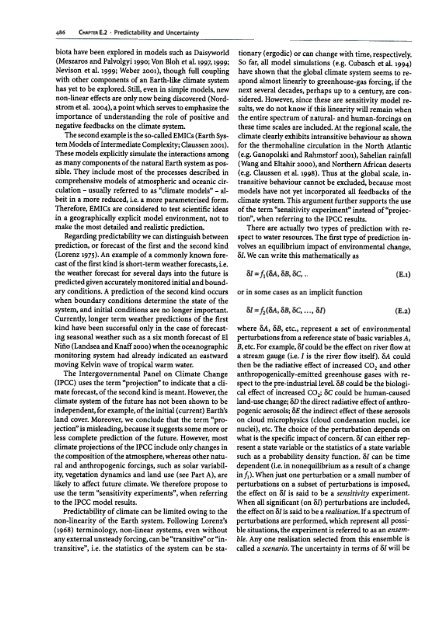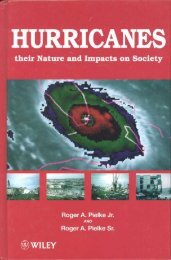How to evaluate vulnerability in changing environmental conditions
How to evaluate vulnerability in changing environmental conditions
How to evaluate vulnerability in changing environmental conditions
Create successful ePaper yourself
Turn your PDF publications into a flip-book with our unique Google optimized e-Paper software.
486<br />
CHAPTER E.2 .Predictability and Uncerta<strong>in</strong>ty<br />
biota have been explored <strong>in</strong> models such as Daisyworld tionary (ergodic) or can change with time, respectively.<br />
(Meszaros and Palvolgyi 1990; Von Bloh et al. 1997, 1999; So far, all model simulaltions (e.g. Cubasch et al. 1994)<br />
Nevison et al. 1999; Weber 2001), though full coupl<strong>in</strong>g have shown that the global climate system seems <strong>to</strong> re-<br />
with other components of an Earth-like climate system spond almost l<strong>in</strong>early <strong>to</strong> greenhouse-gas forc<strong>in</strong>g, if the<br />
has yet <strong>to</strong> be explored. Still, even <strong>in</strong> simple models, new next several decades, perhaps up <strong>to</strong> a century, are con-<br />
non-l<strong>in</strong>ear effects are only now be<strong>in</strong>g discovered (Nordsidered. <strong>How</strong>ever, s<strong>in</strong>ce these are sensitivity model restrom<br />
et al. 2004), a po<strong>in</strong>t which serves <strong>to</strong> emphasize the sults, we do not know if this l<strong>in</strong>earity will rema<strong>in</strong> when<br />
importance of understand<strong>in</strong>g the role of positive and the entire spectrum of natural- and human-forc<strong>in</strong>gs on<br />
negative feedbacks on the climate system.<br />
these time scales are <strong>in</strong>cluded. At the regional scale, the<br />
The second example is the so-called EMICs (Earth Sys- climate clearly exhibits <strong>in</strong>transitive behaviour as shown<br />
tem Models of Intermediate Complexity; Claussen 2001). for the thermohal<strong>in</strong>e circulation <strong>in</strong> the North Atlantic<br />
These models explicitly simulate the <strong>in</strong>teractions among (e.g. Ganopolski and RaJl1ms<strong>to</strong>rf 2001), Sahelian ra<strong>in</strong>fall<br />
as many components of the natural Earth system as pos- (Wang and Eltahir 2000), and Northern African deserts<br />
sible. They <strong>in</strong>clude most of the processes described <strong>in</strong> (e.g. Claussen et al. 199fl). Thus at the global scale, <strong>in</strong>-<br />
comprehensive models of atmospheric and oceanic cirtransitive behaviour Ca11tnot be excluded, because most<br />
culation -usually referred <strong>to</strong> as "climate models" -al- models have not yet <strong>in</strong>c:orporated all feedbacks of the<br />
beit <strong>in</strong> a more reduced, i.e. a more parameterised form. climate system. This argument further supports the use<br />
Therefore, EMICs are considered <strong>to</strong> test scientific ideas of the term "sensitivity I~xperiment" <strong>in</strong>stead of"projec-<br />
<strong>in</strong> a geographically explicit model environment, not <strong>to</strong> tion", when referr<strong>in</strong>g <strong>to</strong> the IPCC results.<br />
make the most detailed and realistic prediction.<br />
There are actually tv.ro types of prediction with re-<br />
Regard<strong>in</strong>g predictability we can dist<strong>in</strong>guish between spect <strong>to</strong> water resources. The first type of prediction <strong>in</strong>-<br />
prediction, or forecast of the first and the second k<strong>in</strong>d volves an equilibrium impact of <strong>environmental</strong> change,<br />
(Lorenz 1975). An example of a commonly known forecast<br />
of the first k<strong>in</strong>d is short-term weather forecasts, i.e.<br />
01. We can write this ma1:hematically as<br />
the weather forecast for several days <strong>in</strong><strong>to</strong> the future is<br />
predicted given accurately moni<strong>to</strong>red <strong>in</strong>itial and bound-<br />
01= fJ(OA,OB, OC,. (E.!)<br />
ary <strong>conditions</strong>. A prediction of the second k<strong>in</strong>d occurs<br />
when boundary <strong>conditions</strong> determ<strong>in</strong>e the state of the<br />
or <strong>in</strong> some cases as an implicit function<br />
system, and <strong>in</strong>itial <strong>conditions</strong> are no longer important.<br />
Currently, longer term weather predictions of the first<br />
SI= h(SA, SB, SC, ..., S1) (E.2)<br />
k<strong>in</strong>d have been successful only <strong>in</strong> the case of forecast- where OA, on, etc., repl:esent a set of <strong>environmental</strong><br />
<strong>in</strong>g seasonal weather such as a six month forecast of EI perturbations from a ref~~rence state of basic variables A,<br />
N<strong>in</strong>o (Landsea and Knaff 2000) when the oceanographic B, etc. For example, 01 colwd be the effect on river flow at<br />
moni<strong>to</strong>r<strong>in</strong>g system had already <strong>in</strong>dicated an eastward a stream gauge (i.e. 1 is the river flow itself). oA could<br />
mov<strong>in</strong>g Kelv<strong>in</strong> wave of tropical warm water.<br />
then be the radiative effi~ct of <strong>in</strong>creased CO2 and other<br />
The Intergovernmental Panel on Climate Change anthropogenically-emit1:ed greenhouse gases with re-<br />
(IPCC) uses the term "projection" <strong>to</strong> <strong>in</strong>dicate that a clispect <strong>to</strong> the pre-<strong>in</strong>dustri~l1level. oB could be the biologimate<br />
forecast, of the second k<strong>in</strong>d is meant. <strong>How</strong>ever, the cal effect of <strong>in</strong>creased CIJ2; oC could be human-caused<br />
climate system of the future has not been shown <strong>to</strong> be land-use change; oD the direct radiative effect of anthro-<br />
<strong>in</strong>dependent, for example, of the <strong>in</strong>itial (current) Earth's pogenic aerosols; oE the <strong>in</strong>direct effect of these aerosols<br />
land cover. Moreover, we conclude that the term "pro- on cloud microphysics (cloud condensation nuclei, ice<br />
jection" is mislead<strong>in</strong>g, because it suggests some more or nuclei), etc. The choice of the perturbation depends on<br />
less complete prediction of the future. <strong>How</strong>ever, most what is the specific impal~t of concern. 01 can either rep-<br />
climate projections of the IPCC <strong>in</strong>clude only changes <strong>in</strong> resent a state variable or the statistics of a state variable<br />
the composition of the atmosphere, whereas other natu- such as a probability density function. 01 can be time<br />
ral and anthropogenic forc<strong>in</strong>gs, such as solar variabil- dependent (i.e. <strong>in</strong> noneqlillibrium as a result of a change<br />
ity, vegetation dynamics and land use (see Part A), are <strong>in</strong>.!;). When just one perturbation or a small number of<br />
likely <strong>to</strong> affect future climate. We therefore propose <strong>to</strong> perturbations on a subs~~t of perturbations is imposed,<br />
use the term "sensitivity experiments", when referr<strong>in</strong>g the effect on 01 is said <strong>to</strong> be a sensitivity experiment.<br />
<strong>to</strong> the IPCC model results.<br />
When all significant (on 01) perturbations are <strong>in</strong>cluded,<br />
Predictability of climate can be limited ow<strong>in</strong>g <strong>to</strong> the the effect on 01 is said <strong>to</strong> be a realisation. If a spectrum of<br />
non-l<strong>in</strong>earity of the Earth system. Follow<strong>in</strong>g Lorenz's perturbations are perforlmed, which represent all possi-<br />
(1968) term<strong>in</strong>ology, non-l<strong>in</strong>ear systems, even without ble situations, the experiment is referred <strong>to</strong> as an ensem-<br />
any external unsteady forc<strong>in</strong>g, can be "transitive" or "<strong>in</strong>ble. Anyone realisation selected from this ensemble is<br />
transitive", i.e. the statistics of the system can be sta-<br />
called a scenario. The uncerta<strong>in</strong>ty <strong>in</strong> terms of 01 will be














